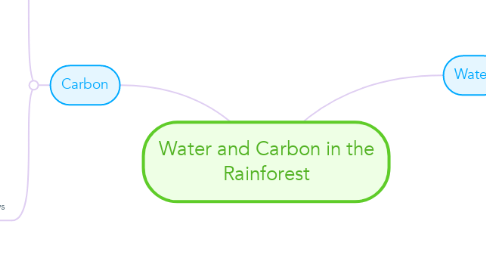
1. Water
1.1. Precipitation
1.1.1. There is a lot of rain in rain-forest hence the name. This is because they are based along the equator where it is extremely humid and because it is so hot the oceans there evaporate more.
1.2. Absorption
1.2.1. Plants and trees absorb a large amount of water through their roots. This is so their cells stay hydrated and they can grow strong.
1.3. Transportation
1.3.1. Plants move water up their stems via transpiration and evaporates out of the leaves.
1.4. Condensation
1.4.1. When warm water vapour in the air comes in contact with a cool surface for example the leaves of plants it cools down and re-condenses back into water. This water can then run down the plant and into the soil allowing it to be absorbed.
2. Carbon
2.1. Carbon Stores
2.1.1. Ground Carbon
2.1.1.1. Another huge store of carbon in the rainforest would be the carbon stored underground. This carbon is trapped down there so cannot be released back into the atmosphere unlike if it was stored in a tree which then burned down.
2.1.2. Animals
2.1.2.1. Animals in the rainforest are all carbon based lifeforms. This means that they are also stores of carbon.
2.1.3. Trees & Plant life
2.1.3.1. These are the main stores of carbon in the rainforest. Specifically trees as they cover the majority of the rainforest floor with their thick trunks that are made of compact carbon causing them to be a very efficient store.
2.2. Carbon Flows
2.2.1. Combustion (Output)
2.2.1.1. A large quanitiy of carbon will be released from the rainforest due to trees animals and plantlife being burned in forest fires or similar evens. The carbon will be released into the atmosphere as CO2
2.2.2. Photosynthesis (Input)
2.2.2.1. All of the vast array of plants in the rainforest photosynthesis to provide energy to their cells. This means that they take CO2 out of the atmosphere and use it in a reaction releasing O2 as a product and tunring the carbon into a different usefull product meaning carbon has moved from the atmosphere to the land.
2.2.3. Respiration (Output)
2.2.3.1. Animals respire to provide energy for their cells. They do this by taking in O2 and releasing CO2 which is the opposite of what plants do in photosynthesis and consequently release carbon back into the atmosphere.
2.2.4. Ingestion (Transfer)
2.2.4.1. Animals can eat plants and other animals meaning that the carbon their bodies are made out of is transferred up the food chain. However some will be lost at each stage and returned to the ground as it is not possible to eat. For example the bones of an animal.
